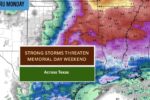An early-season heat wave is set to bring record or near-record high temperatures across a vast portion of the United States this week, as a heat dome settles over the Southwest, Texas, and parts of the northern and southern Plains.
The National Weather Service (NWS) is warning residents from North Dakota to Florida to prepare for dangerously high temperatures, which in some areas could surpass 110°F—a rare occurrence this early in the year.
What Is a Heat Dome?
At the center of this extreme weather event is a high-pressure ridge, commonly referred to as a heat dome. This meteorological phenomenon traps hot air beneath it, allowing temperatures to build day after day without much relief. This particular system is centered over Texas and is expected to intensify throughout the week.
“Expect record-breaking heat across much of central and southern Texas through mid-week,” the NWS warned in its short-range forecast on Monday.
Where Will It Be Hottest?
The most severe conditions are expected to begin Tuesday, especially in central and southern Texas, where triple-digit temperatures will be widespread.
Forecasted hot spots include:
- Austin, Dallas, San Antonio, and Houston, Texas
- Oklahoma City, Oklahoma
- Shreveport, Louisiana
- Charleston, South Carolina
- Tallahassee, Jacksonville, and Orlando, Florida
Meanwhile, states in the northern Plains—such as North Dakota, South Dakota, and Minnesota—will also see unseasonably warm temperatures, reaching into the upper 90s and low 100s on Monday.
“Temperatures are forecast to surge above 100 Tuesday, and some places could approach 110 midweek,” the NWS San Antonio office wrote on X (formerly Twitter).
“Ensure you have access to cooling and plentiful hydration before the heat arrives.”
Public Health Risks: Heat Illness and Acclimation
Meteorologists and health experts are concerned that the timing of the heat wave—so early in the season—could catch people off guard, especially those not yet acclimated to intense summer temperatures.
“Many people will not be acclimated to such extreme heat so early in the year,” NWS officials said, emphasizing that heat-related illnesses and deaths could spike.
To stay safe, residents are advised to:
- Limit outdoor activities during peak afternoon hours
- Stay hydrated throughout the day
- Use air conditioning or seek out cooling centers
- Check on vulnerable groups, such as elderly neighbors and young children
Record Highs Already Broken in California
While Texas prepares for the brunt of the heat, the West has already seen temperature records fall. Over the weekend, Southern California experienced record highs, with downtown Los Angeles hitting 103°F, surpassing a previous record of 99°F set in 1988, according to the NWS Los Angeles office.
The Bigger Picture: Climate Change
This early-season heat wave is part of a larger pattern of extreme weather that scientists attribute to climate change. Research shows that warming global temperatures are increasing the frequency, duration, and intensity of heat waves worldwide.
According to the National Oceanic and Atmospheric Administration (NOAA), the 10 hottest years on Earth since 1850 have all occurred in the past decade.
“Back-to-back years of record heat in 2023 and 2024 are part of an alarming trend,” NOAA said in its annual climate assessment.
“The models have long predicted this, and the data is now confirming it.”
With another hot summer expected in 2025, public health experts are urging state and local governments to prepare cooling infrastructure, improve climate resilience, and promote heat safety awareness.
Tips for Staying Safe During Extreme Heat
If you’re living in or traveling through affected regions this week, here are NWS-recommended precautions:
- Drink water regularly, even if you’re not thirsty
- Wear lightweight, light-colored clothing
- Stay indoors during peak sunlight hours (10 a.m. to 4 p.m.)
- Avoid strenuous activities outdoors
- Never leave children or pets in cars, even briefly
- Monitor updates via weather.gov and local emergency services
Looking Ahead
The heat dome is expected to persist through mid-week, with possible expansion into the Southeast and Florida by the weekend. While some relief may come from a weakening of the ridge later this week, the event has already drawn attention as a preview of summer 2025, which climate scientists warn could again break global heat records.
For now, Texas and much of the central U.S. remain in the grip of an oppressive heat wave, reminding residents and officials alike of the growing urgency around climate preparedness.
This article has been carefully fact-checked by our editorial team to ensure accuracy and eliminate any misleading information. We are committed to maintaining the highest standards of integrity in our content.

Outside of work, he enjoys playing chess, following cricket, and writing short stories. His commitment to integrity and in-depth analysis strengthens OTE News’ mission of providing trustworthy journalism.




